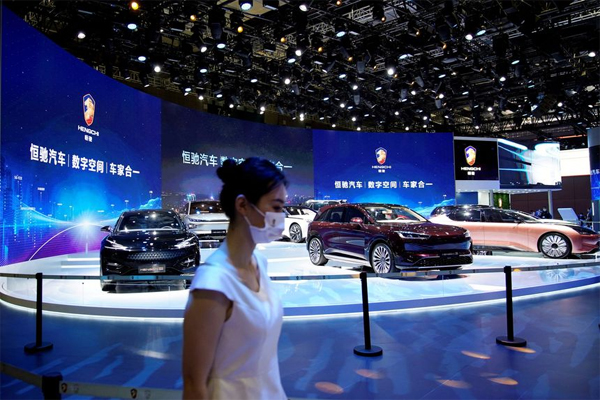
Cheap credit and political subsidies led startups to let their ambitions get ahead of market realities.
A parade of electric-vehicle startups have gone public in recent years and commanded multibillion-dollar valuations—Rivian, Nikola, Canoo, Lordstown, Fisker, Workhorse Group, Mullen Automotive and Lucid. Most had never sold a single car at their public debut. Fueled by cheap credit and political subsidies, their stocks surged, only to crash. Their ambitions were ahead of reality.
The same is true of Democrats who want to replace gasoline-powered cars with supposedly climate-friendly electric vehicles. Consider the problems now befalling China, the world leader in electric-vehicle production and exports. Beijing has set aggressive production quotas for car makers and provided generous subsidies for buyers. China’s annual electric-vehicle production capacity has ballooned to 5.7 million vehicles—for comparison, 434,879 electric vehicles were sold in the U.S. last year—and is expected to hit 15 million in a couple of years.
Yet concerns are mounting in China about oversupply of what the country calls new energy vehicles. “Reckless investments and disorderly efforts can be seen in the country’s NEV industry,” Lin Nianxiu, vice chairman of the National Development and Reform Commission, warned in March. “We have too many EV firms,” Xiao Yaqing, minister of industry and information technology, said in September.
Some 200 Chinese EV startups have launched in the chase for government subsidies. Many have struggled to scale up production, and some have gone bankrupt. Foreign auto makers, possibly excepting Tesla, are struggling to sell electric vehicles in a saturated Chinese market. China’s problem is twofold: too much investment chasing too little demand, and too many companies with too little profit. The U.S. is starting to see the same problems.
Almost all EV startups went public by merging with SPACs, or special-purpose acquisition companies. That allowed them to avoid required financial disclosures and make exceedingly rosy business projections. The Federal Reserve encouraged risky investing by holding down short- and long-term interest rates. Easy money provided an enormous subsidy. But now the cost of capital is rising as the Fed tightens, and so are production costs as prices for lithium, nickel and cobalt surge. Rivian recently increased the price of its pickup truck by $12,000, to $79,500, to offset rising costs.
These so-called unicorns are rapidly burning through cash. Canoo, which is producing 12 vehicles a week, last week warned that “substantial doubt exists about the Company’s ability to continue as a going concern” in the next year. Lordstown Motors, which recently sold a former General Motors plant it had bought in Ohio, issued a similar warning this week. The company says its ability to remain in business will depend on raising more capital and its stock price.
Difficulties raising capital and logistic snarls are causing unicorns to delay vehicle launches and slash production projections. As a result, their stock prices have plunged. Shares in Rivian, Canoo, Nikola, Mullen Automotive, Lordstown and Workhorse Group are trading 80% to 95% below their peaks.
Early investors are getting creamed. But their travails are good news for traditional auto makers, which are investing heavily in EV production to comply with government mandates. GM plans to produce only electric cars by 2035. Ford has bet big on its electric F-150 Lightning pickup, which is getting rave media reviews and boasts some 200,000 potential buyers on its wait list.
With a roughly $40,000 base price tag, the electric F-150 is only $10,000 more expensive than its gasoline-powered model. But it’s unclear whether Ford can make a profit selling the pickups at this price. Traditional makers are aiming to reduce costs of EVs—and thereby drum up demand—by scaling up production. Yet this may mean they lose money on each EV they sell for some time until there’s a battery technology breakthrough.
Auto makers also still face a significant risk that consumer demand won’t keep pace with supply. This is Detroit’s Big Three have been lobbying hard for President Biden’s Build Back Better plan. The bill would provide $12,500 tax credits for electric cars made at union auto plants in the U.S. and extend the current $7,500 credit through 2031 for nonunion plants.
Electric vehicles have some advantages. They are cheaper to maintain. Charging a car with electricity in most places costs less than fueling with gasoline. But electric cars are still on average 35% more expensive than gas-powered ones, and the price disparity is likely to increase as demand for critical minerals grows.
Most EVs today can’t go more than 250 miles on a charge (and less in cold weather). Drivers worry for good reason that they’ll run out of juice on the road. President Biden hopes to alleviate this so-called range anxiety by subsidizing a nationwide network of charging stations. This won’t solve the problem. Public charging stations are nowhere more ubiquitous than in California’s Bay Area. But a recent study found that less than three-quarters of charging stations worked. In many cases the plugs, screens or payment systems were broken, or connector cables weren’t long enough to reach the car’s port. Imagine if 25% of the nation’s gasoline stations weren’t working and drivers didn’t know until they got out of the car whether they’d be able to fill up.
Much still needs to be worked out before widespread adoption of EVs is feasible. Yet the Biden administration and states like California plan to use fuel-economy and emissions mandates to force auto makers to phase out conventional vehicles. What happens if electric cars don’t sell? Perhaps auto makers would lobby politicians for higher gasoline taxes to boost EV sales, as they are doing in Europe. More likely they’d discount electric cars and raise prices on gasoline-powered ones to compensate. The alternative would be bankruptcy.
Mr. Biden says he wants to beat China in the electric-vehicle race. Americans would be better off if government didn’t try to drive the market.
Almost all EV startups went public by merging with SPACs, or special-purpose acquisition companies. That allowed them to avoid required financial disclosures and make exceedingly rosy business projections. The Federal Reserve encouraged risky investing by holding down short- and long-term interest rates. Easy money provided an enormous subsidy. But now the cost of capital is rising as the Fed tightens, and so are production costs as prices for lithium, nickel and cobalt surge. Rivian recently increased the price of its pickup truck by $12,000, to $79,500, to offset rising costs.
These so-called unicorns are rapidly burning through cash. Canoo, which is producing 12 vehicles a week, last week warned that “substantial doubt exists about the Company’s ability to continue as a going concern” in the next year. Lordstown Motors, which recently sold a former General Motors plant it had bought in Ohio, issued a similar warning this week. The company says its ability to remain in business will depend on raising more capital and its stock price.
Difficulties raising capital and logistic snarls are causing unicorns to delay vehicle launches and slash production projections. As a result, their stock prices have plunged. Shares in Rivian, Canoo, Nikola, Mullen Automotive, Lordstown and Workhorse Group are trading 80% to 95% below their peaks.
Early investors are getting creamed. But their travails are good news for traditional auto makers, which are investing heavily in EV production to comply with government mandates. GM plans to produce only electric cars by 2035. Ford has bet big on its electric F-150 Lightning pickup, which is getting rave media reviews and boasts some 200,000 potential buyers on its wait list.
With a roughly $40,000 base price tag, the electric F-150 is only $10,000 more expensive than its gasoline-powered model. But it’s unclear whether Ford can make a profit selling the pickups at this price. Traditional makers are aiming to reduce costs of EVs—and thereby drum up demand—by scaling up production. Yet this may mean they lose money on each EV they sell for some time until there’s a battery technology breakthrough.
Auto makers also still face a significant risk that consumer demand won’t keep pace with supply. This is Detroit’s Big Three have been lobbying hard for President Biden’s Build Back Better plan. The bill would provide $12,500 tax credits for electric cars made at union auto plants in the U.S. and extend the current $7,500 credit through 2031 for nonunion plants.
Electric vehicles have some advantages. They are cheaper to maintain. Charging a car with electricity in most places costs less than fueling with gasoline. But electric cars are still on average 35% more expensive than gas-powered ones, and the price disparity is likely to increase as demand for critical minerals grows.
Most EVs today can’t go more than 250 miles on a charge (and less in cold weather). Drivers worry for good reason that they’ll run out of juice on the road. President Biden hopes to alleviate this so-called range anxiety by subsidizing a nationwide network of charging stations. This won’t solve the problem. Public charging stations are nowhere more ubiquitous than in California’s Bay Area. But a recent study found that less than three-quarters of charging stations worked. In many cases the plugs, screens or payment systems were broken, or connector cables weren’t long enough to reach the car’s port. Imagine if 25% of the nation’s gasoline stations weren’t working and drivers didn’t know until they got out of the car whether they’d be able to fill up.
Much still needs to be worked out before widespread adoption of EVs is feasible. Yet the Biden administration and states like California plan to use fuel-economy and emissions mandates to force auto makers to phase out conventional vehicles. What happens if electric cars don’t sell? Perhaps auto makers would lobby politicians for higher gasoline taxes to boost EV sales, as they are doing in Europe. More likely they’d discount electric cars and raise prices on gasoline-powered ones to compensate. The alternative would be bankruptcy.
Mr. Biden says he wants to beat China in the electric-vehicle race. Americans would be better off if government didn’t try to drive the market.
Ms. Finley is a member of the Journal’s editorial board.
Almost all EV startups went public by merging with SPACs, or special-purpose acquisition companies. That allowed them to avoid required financial disclosures and make exceedingly rosy business projections. The Federal Reserve encouraged risky investing by holding down short- and long-term interest rates. Easy money provided an enormous subsidy. But now the cost of capital is rising as the Fed tightens, and so are production costs as prices for lithium, nickel and cobalt surge. Rivian recently increased the price of its pickup truck by $12,000, to $79,500, to offset rising costs.
These so-called unicorns are rapidly burning through cash. Canoo, which is producing 12 vehicles a week, last week warned that “substantial doubt exists about the Company’s ability to continue as a going concern” in the next year. Lordstown Motors, which recently sold a former General Motors plant it had bought in Ohio, issued a similar warning this week. The company says its ability to remain in business will depend on raising more capital and its stock price.
Difficulties raising capital and logistic snarls are causing unicorns to delay vehicle launches and slash production projections. As a result, their stock prices have plunged. Shares in Rivian, Canoo, Nikola, Mullen Automotive, Lordstown and Workhorse Group are trading 80% to 95% below their peaks.
Early investors are getting creamed. But their travails are good news for traditional auto makers, which are investing heavily in EV production to comply with government mandates. GM plans to produce only electric cars by 2035. Ford has bet big on its electric F-150 Lightning pickup, which is getting rave media reviews and boasts some 200,000 potential buyers on its wait list.
With a roughly $40,000 base price tag, the electric F-150 is only $10,000 more expensive than its gasoline-powered model. But it’s unclear whether Ford can make a profit selling the pickups at this price. Traditional makers are aiming to reduce costs of EVs—and thereby drum up demand—by scaling up production. Yet this may mean they lose money on each EV they sell for some time until there’s a battery technology breakthrough.
Auto makers also still face a significant risk that consumer demand won’t keep pace with supply. This is Detroit’s Big Three have been lobbying hard for President Biden’s Build Back Better plan. The bill would provide $12,500 tax credits for electric cars made at union auto plants in the U.S. and extend the current $7,500 credit through 2031 for nonunion plants.
Electric vehicles have some advantages. They are cheaper to maintain. Charging a car with electricity in most places costs less than fueling with gasoline. But electric cars are still on average 35% more expensive than gas-powered ones, and the price disparity is likely to increase as demand for critical minerals grows.
Most EVs today can’t go more than 250 miles on a charge (and less in cold weather). Drivers worry for good reason that they’ll run out of juice on the road. President Biden hopes to alleviate this so-called range anxiety by subsidizing a nationwide network of charging stations. This won’t solve the problem. Public charging stations are nowhere more ubiquitous than in California’s Bay Area. But a recent study found that less than three-quarters of charging stations worked. In many cases the plugs, screens or payment systems were broken, or connector cables weren’t long enough to reach the car’s port. Imagine if 25% of the nation’s gasoline stations weren’t working and drivers didn’t know until they got out of the car whether they’d be able to fill up.
Much still needs to be worked out before widespread adoption of EVs is feasible. Yet the Biden administration and states like California plan to use fuel-economy and emissions mandates to force auto makers to phase out conventional vehicles. What happens if electric cars don’t sell? Perhaps auto makers would lobby politicians for higher gasoline taxes to boost EV sales, as they are doing in Europe. More likely they’d discount electric cars and raise prices on gasoline-powered ones to compensate. The alternative would be bankruptcy.
Mr. Biden says he wants to beat China in the electric-vehicle race. Americans would be better off if government didn’t try to drive the market.
Ms. Finley is a member of the Journal’s editorial board.
Almost all EV startups went public by merging with SPACs, or special-purpose acquisition companies. That allowed them to avoid required financial disclosures and make exceedingly rosy business projections. The Federal Reserve encouraged risky investing by holding down short- and long-term interest rates. Easy money provided an enormous subsidy. But now the cost of capital is rising as the Fed tightens, and so are production costs as prices for lithium, nickel and cobalt surge. Rivian recently increased the price of its pickup truck by $12,000, to $79,500, to offset rising costs.
These so-called unicorns are rapidly burning through cash. Canoo, which is producing 12 vehicles a week, last week warned that “substantial doubt exists about the Company’s ability to continue as a going concern” in the next year. Lordstown Motors, which recently sold a former General Motors plant it had bought in Ohio, issued a similar warning this week. The company says its ability to remain in business will depend on raising more capital and its stock price.
Difficulties raising capital and logistic snarls are causing unicorns to delay vehicle launches and slash production projections. As a result, their stock prices have plunged. Shares in Rivian, Canoo, Nikola, Mullen Automotive, Lordstown and Workhorse Group are trading 80% to 95% below their peaks.
Early investors are getting creamed. But their travails are good news for traditional auto makers, which are investing heavily in EV production to comply with government mandates. GM plans to produce only electric cars by 2035. Ford has bet big on its electric F-150 Lightning pickup, which is getting rave media reviews and boasts some 200,000 potential buyers on its wait list.
With a roughly $40,000 base price tag, the electric F-150 is only $10,000 more expensive than its gasoline-powered model. But it’s unclear whether Ford can make a profit selling the pickups at this price. Traditional makers are aiming to reduce costs of EVs—and thereby drum up demand—by scaling up production. Yet this may mean they lose money on each EV they sell for some time until there’s a battery technology breakthrough.
Auto makers also still face a significant risk that consumer demand won’t keep pace with supply. This is Detroit’s Big Three have been lobbying hard for President Biden’s Build Back Better plan. The bill would provide $12,500 tax credits for electric cars made at union auto plants in the U.S. and extend the current $7,500 credit through 2031 for nonunion plants.
Electric vehicles have some advantages. They are cheaper to maintain. Charging a car with electricity in most places costs less than fueling with gasoline. But electric cars are still on average 35% more expensive than gas-powered ones, and the price disparity is likely to increase as demand for critical minerals grows.
Most EVs today can’t go more than 250 miles on a charge (and less in cold weather). Drivers worry for good reason that they’ll run out of juice on the road. President Biden hopes to alleviate this so-called range anxiety by subsidizing a nationwide network of charging stations. This won’t solve the problem. Public charging stations are nowhere more ubiquitous than in California’s Bay Area. But a recent study found that less than three-quarters of charging stations worked. In many cases the plugs, screens or payment systems were broken, or connector cables weren’t long enough to reach the car’s port. Imagine if 25% of the nation’s gasoline stations weren’t working and drivers didn’t know until they got out of the car whether they’d be able to fill up.
Much still needs to be worked out before widespread adoption of EVs is feasible. Yet the Biden administration and states like California plan to use fuel-economy and emissions mandates to force auto makers to phase out conventional vehicles. What happens if electric cars don’t sell? Perhaps auto makers would lobby politicians for higher gasoline taxes to boost EV sales, as they are doing in Europe. More likely they’d discount electric cars and raise prices on gasoline-powered ones to compensate. The alternative would be bankruptcy.
Mr. Biden says he wants to beat China in the electric-vehicle race. Americans would be better off if government didn’t try to drive the market.
__________________________________________________________________________________
Ms. Allysia Finley is a member of the Journal’s editorial board. Energiesnet.com does not necessarily share these views.
Editor’s Note: This article was originally published by The Wall Street Journal (WSJ), on May 19, 2022. All comments posted and published on EnergiesNet.com, do not reflect either for or against the opinion expressed in the comment as an endorsement of EnergiesNet.com or Petroleumworld.
Use Notice: This site contains copyrighted material the use of which has not always been specifically authorized by the copyright owner. We are making such material available in our efforts to advance understanding of issues of environmental and humanitarian significance. We believe this constitutes a ‘fair use’ of any such copyrighted material as provided for in section 107 of the US Copyright Law. In accordance with Title 17 U.S.C. Section 107. For more information go to: http://www.law.cornell.edu/uscode/17/107.shtml.
EnergiesNet.com 05 20 2022












